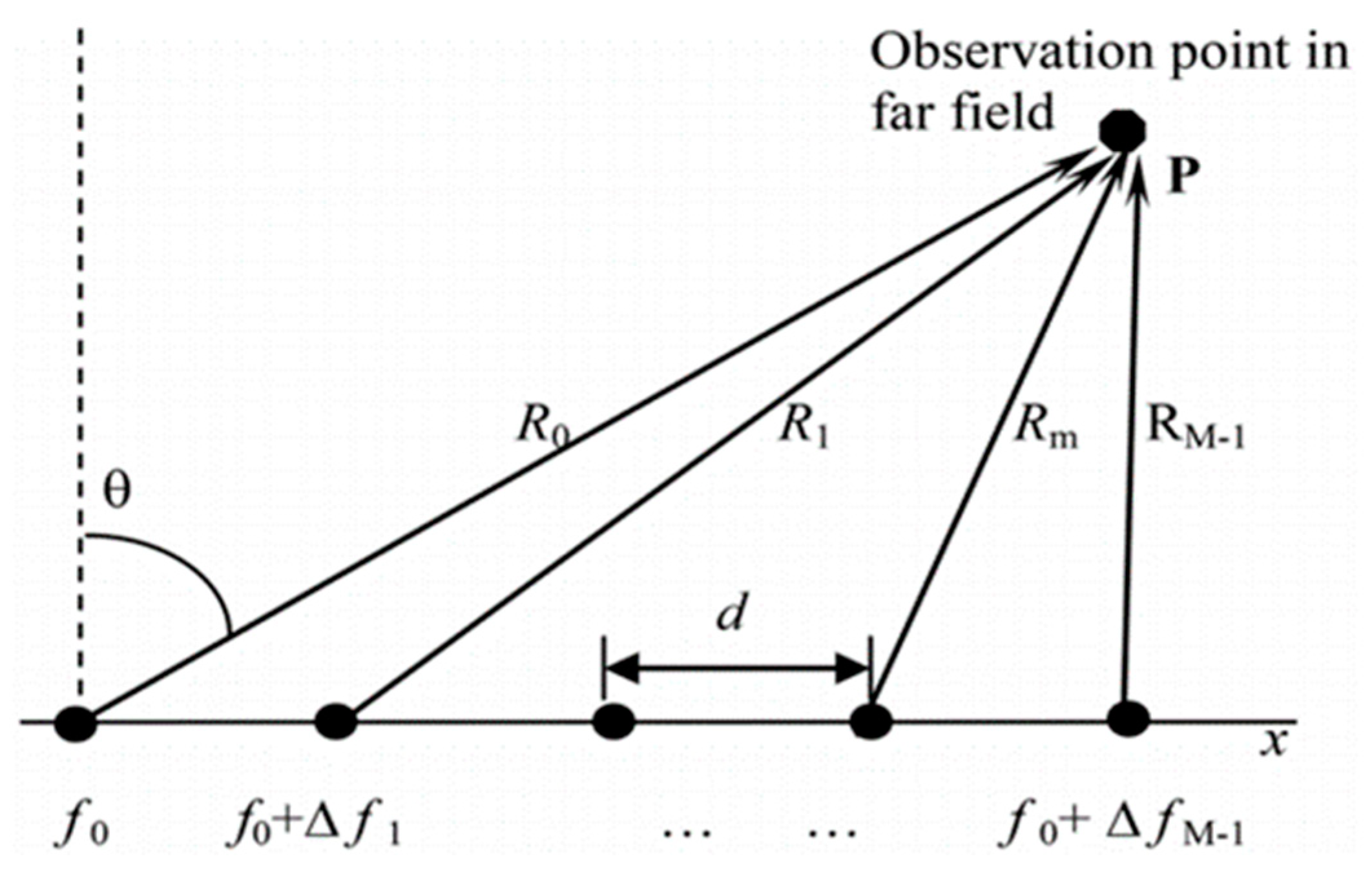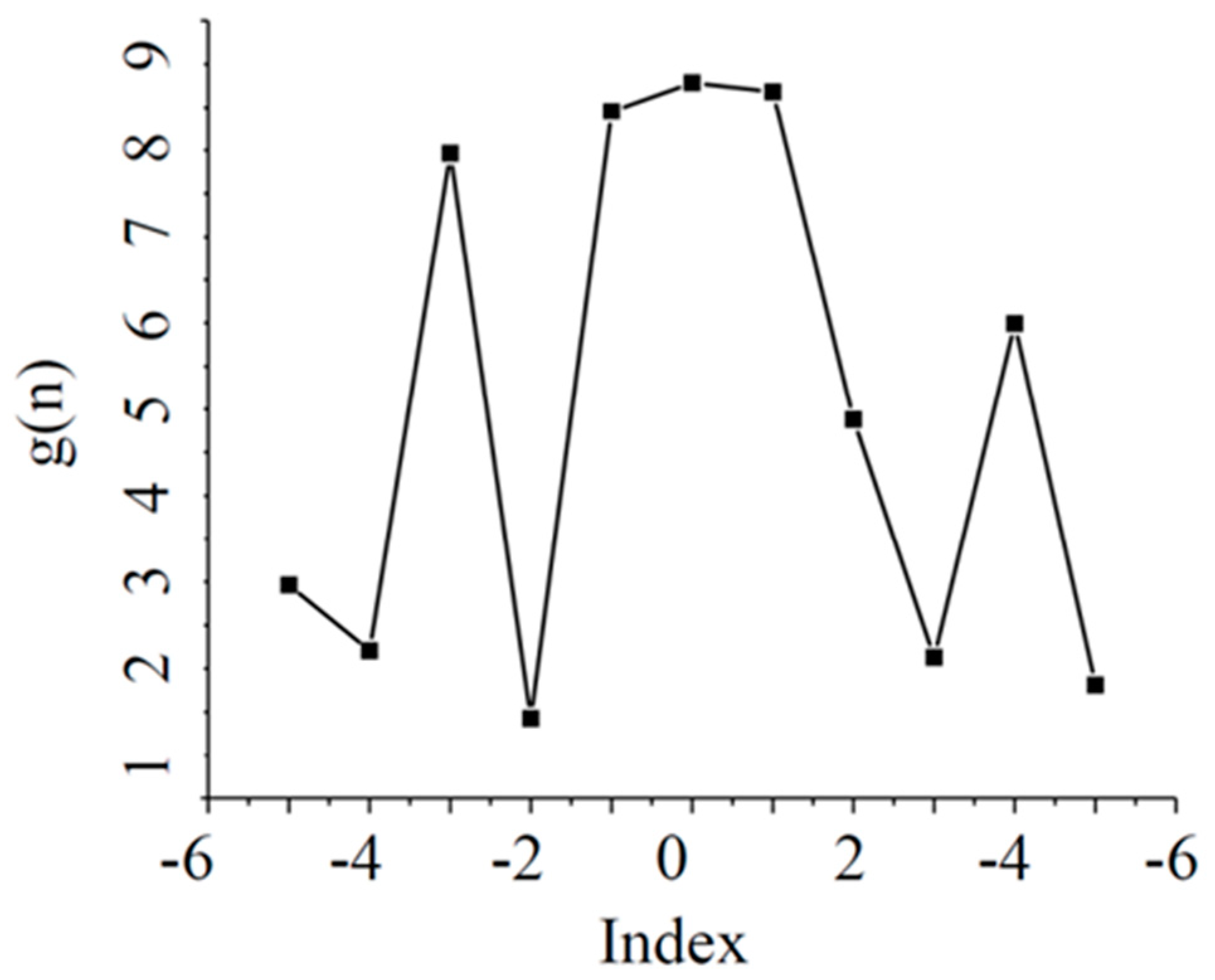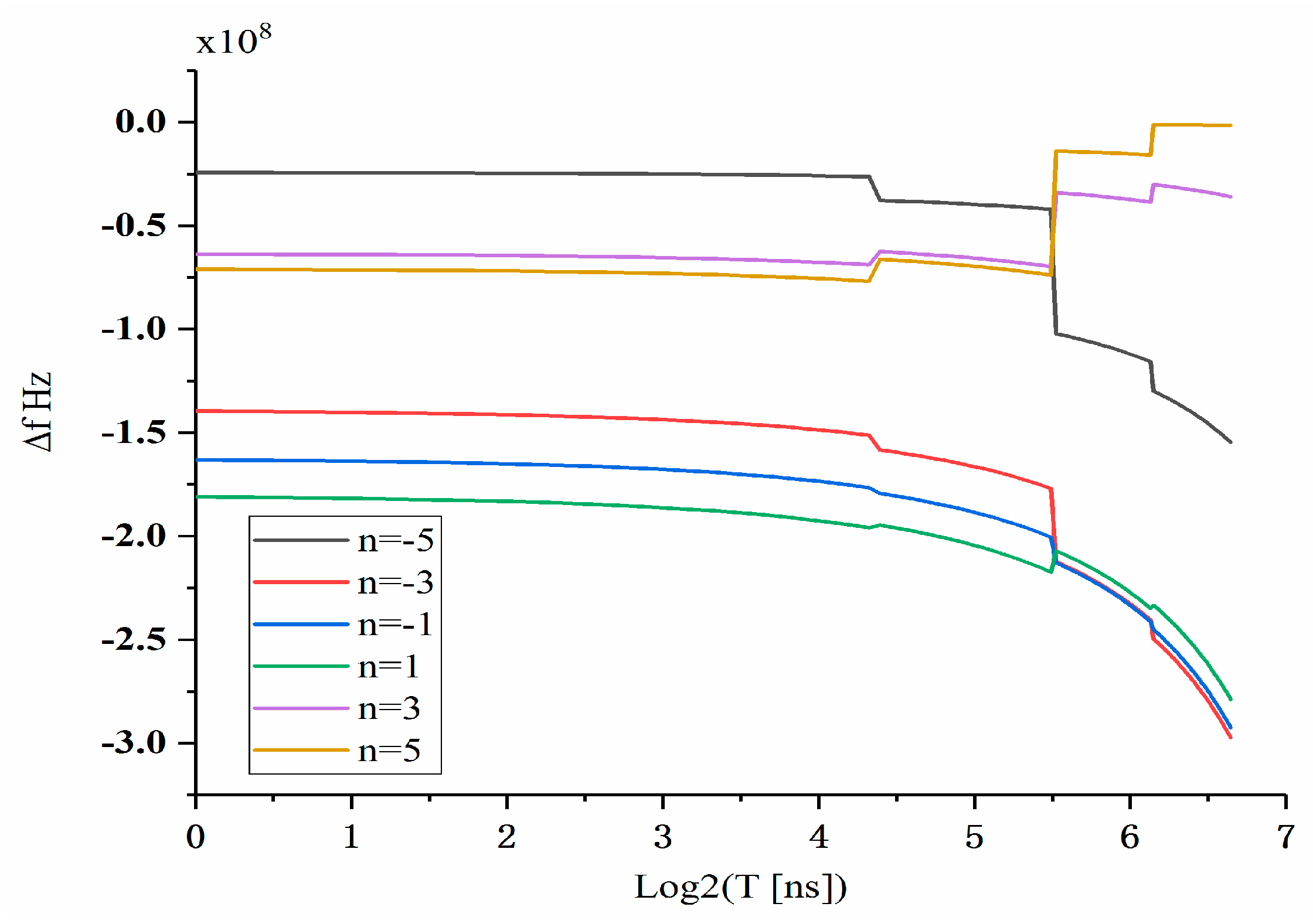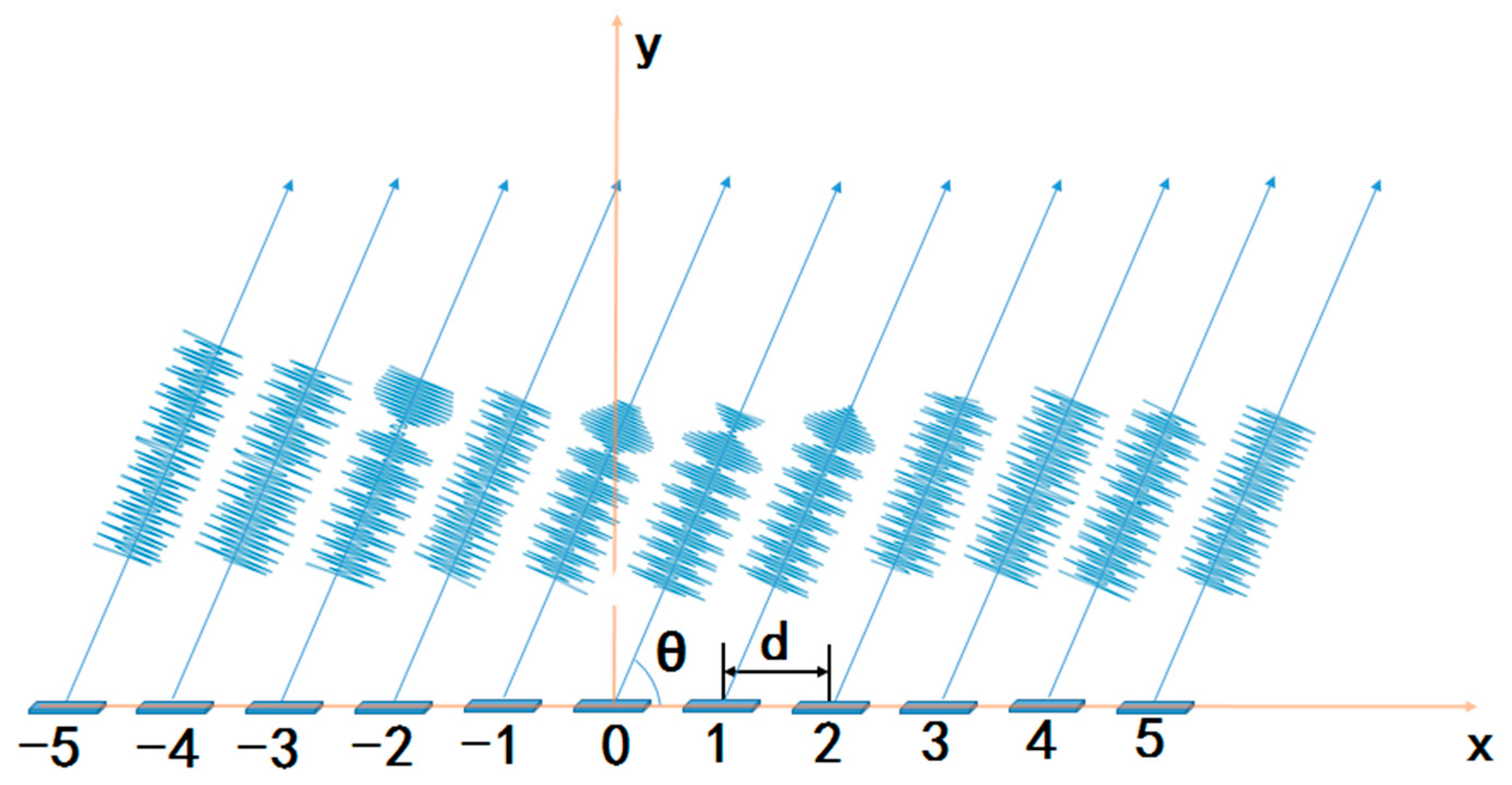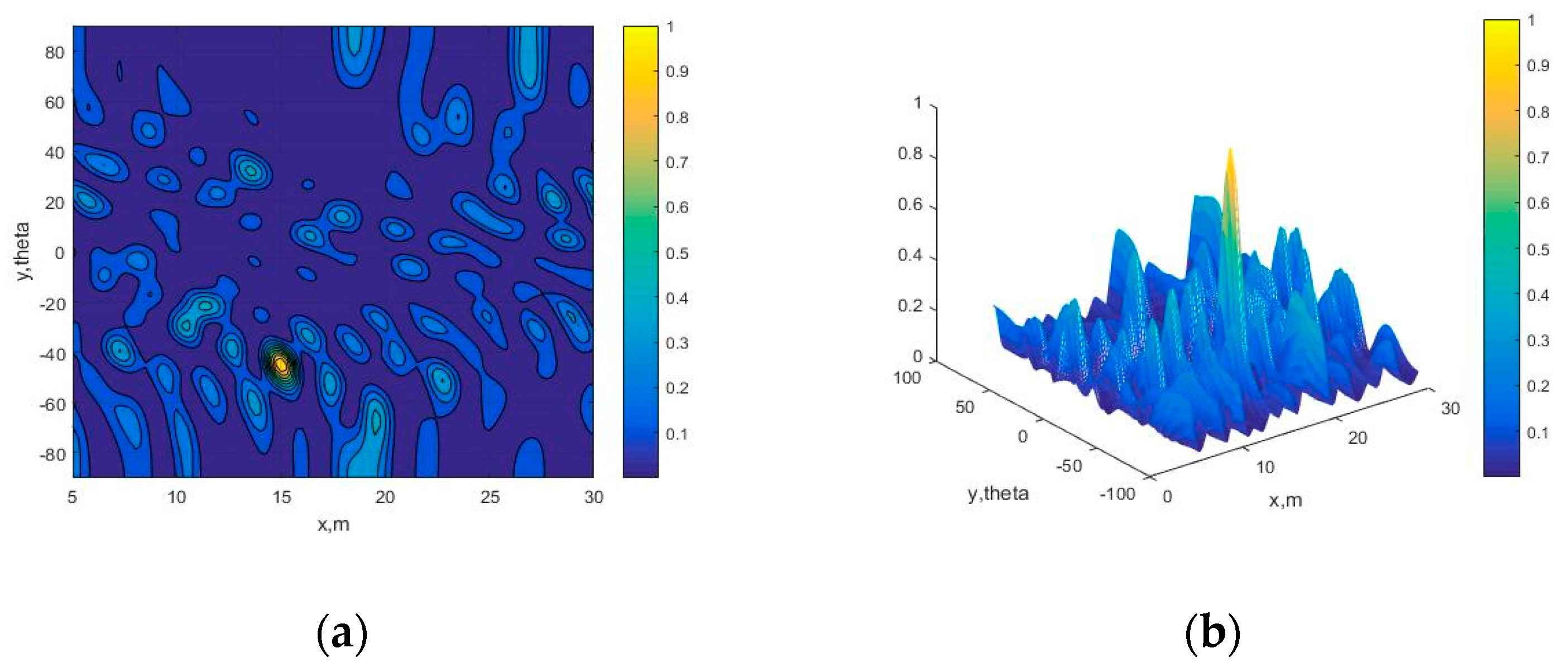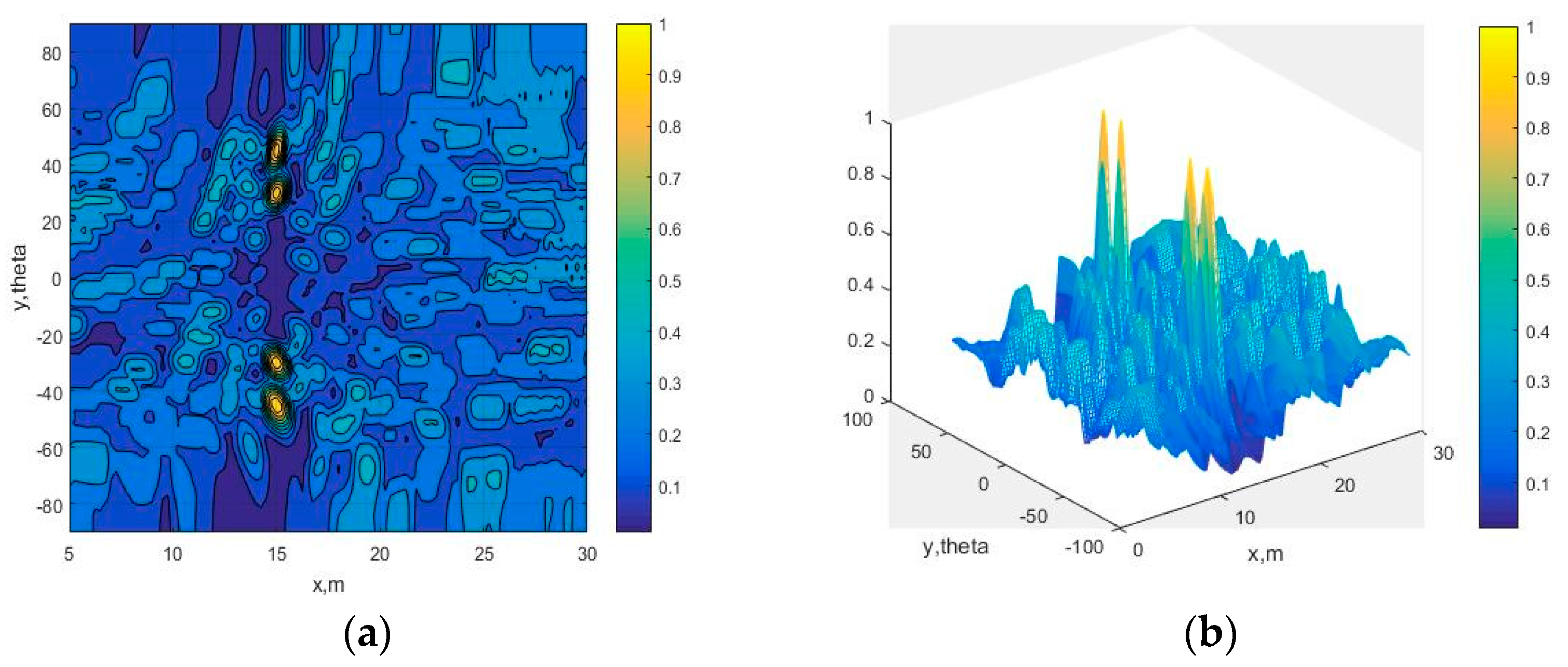1. Introduction
In 2006, P. Antonik and his colleagues first proposed the concept of frequency diversity array antenna based on the research of traditional beam-scanning phased array technique [
1,
2]. It is pointed out that by introducing a progressive small frequency offset at the center frequency of the array element, the pointing direction of the spatial beam will rotate with the change of the distance, thereby realizing the spatial beam scanning without the phase shifter. At the same year, they conducted a preliminary analysis of the relationship between distance and spatial beam of the frequency diversity array under waveform diversity. From 2008 to 2009, they studied the implementation of frequency diversity arrays, as well as frequency and amplitude-phase modulation methods and also verified the characteristics of beam pointing with distance variation of linear frequency offset of frequency diverse array (FDA) [
3,
4]. L. Huang et al. also designed an eight-element uniform linear array with linear frequency offset and tested its radiation characteristics [
5]. The results show that the radiation beam of the array changes not only with the variation of the distance but also with the frequency offset. At the same time, the rate at which the beam scan angle changes with time is also obtained. In 2009, T. Higgins studied the linear frequency offset FDA. The research indicates that the half-power beam-width is narrowing as the frequency offset gradually increases [
6]. It is also pointed out that the FDA can be used to improve the Doppler distance-ambiguity. There will be broad prospects in the field of imaging. In 2012, A. M. Jones extended the linear array of one-dimensional linear frequency offset to a two-dimensional planar array, and analyzed its distance-angle pattern characteristics [
7]. In 2013, J. Shin used the finite difference time domain (FDTD) to perform time-domain full-wave analysis on FDA [
8]. From 2007 to 2014 Demir et al. analyzed the spatial beam scanning characteristics of linear frequency-biased FDA and found that the beam scanning changes periodically in time, distance, and angle, and found the law of periodic variation [
9,
10,
11].
The FDA have great potential to change the traditional information and energy transfer ways [
12,
13,
14]. From 2017, researchers began to concentrate on the study of spatial focusing using FDA technology [
15,
16,
17,
18]. In 2017 A. M. Yao proposed time-modulated FDA for achieving spatial focusing for multiple areas [
15]. The principle is based on modified time modulated optimized frequency offset. It allows the FDA available for fixed-point communication and the signal is not easily intercepted [
16]. In the above studies, the focus spots produced by the FDA were time invariant [
17,
18]. If FDA can be used to generate multi-region time-varying focus, then the confidentiality of FDA communications can be further improved. Therefore, this paper will study the use of FDA to achieve multi-target time-varying focusing. In this paper, according to the theory of the single-target focusing of FDA, by optimizing the relevant parameters, time-varying multi-target focusing is achieved. By limiting the operating frequency band, the feeding signal of the array element cannot exceed the operation band.
2. Effects of Frequency Offset on the Range of Focusing Area
The schematic diagram is shown in
Figure 1. The operating frequencies of the array elements are different. The position of the focusing point can be calculated with the classical equation of the FDA. However, the characteristics of the FDA impose limits on the far-field focus position. Once the limits are exceeded, the focusing behavior is adversely affected. In the case of an isotropic dipole introduced in Reference [
15], for example, the array factor is
where
f0 is the central operation frequency of the FDA,
t is time, Δ
f is the frequency offset of the element,
Rn is the distance from each element to the observation point in far field, and c is the speed of light in vacuum.
In considering the distance limitation,
Rn represents the actual distance without any approximation, and
g(
n) is the corresponding array element parameter. To focus on the target area, we set the phase term of the exponent in Equation (1) to zero and obtain the following frequency offset [
15]:
Since FDA is narrowband in nature, we assume a bandwidth of 10% and proceed with the following derivation on this basis.
2.1. The Frequency Offset is Negative
When the frequency offset is negative (
), Equation (2) shows that, as time increases and with
, (
Rmin is the minimal distance) the absolute value of the denominator gradually decreases. Since the numerator remains the same and only the denominator changes, the absolute value of
is the smallest at
t = 0. When the corresponding frequency
offset is zero, given that the denominator is negative and
is negative, the numerator must be either positive or zero. Therefore, we have
From Equation (2), we have
. If the value of
t is smaller than
and corresponds to
, then we have
And
From simultaneous Equations (3) and (5), we obtain
Since
, Equation (6) may be rewritten as
and we have
2.2. The Frequency Offset is Positive
Similarly, Equation (2) also shows that, as time progresses and with
, the absolute value of the denominator gradually decreases. Since the numerator remains the same and only the denominator changes, the absolute value of
is the smallest at
t = 0. Hence, when the corresponding frequency offset is zero, given that the denominator is negative and
is positive, the numerator must be either negative or zero. Therefore, we have
From Equation (2), we have
. If the value of t is smaller than
and corresponds to
, then we have
And
From Equations (9) and (11), we obtain
Since
, Equation (12) may be rewritten as
and we have
Combining the two categories above, we have
where
k is the specified bandwidth range, with the FDA’s relative bandwidth limited at 10%. If the bandwidth range is increased, the ratio of the maximum distance to the minimum distance will increase, and a wider focus range can be obtained.
Based on the above derivation results, it follows that a certain relationship between the maximum distance and the minimum distance from the array elements to the target point must be satisfied in order to achieve focusing. This relationship is independent of whether the bandwidth change is negative or positive. It is limited mainly by the bandwidth and the distance to the focal point. This relationship is easier to satisfy in the far-field because, compared to the far-field distance, the size of the array can often be neglected. This method is therefore more suited for focusing in the far-field.
2.3. Upper and Lower Limits of Frequency Offset
When using the classic focusing formula of FDA, even though intelligent optimization algorithms can solve some of the parameter optimization problems in spatial focusing, one must still control the range of parameter g(n) in the optimization process and satisfy the specified bandwidth requirements of the FDA; otherwise, the frequency variation may exceed the range and may even lead to negative frequency in the optimization result. Next, we study the allowed range of g(n). Using the classical focusing equation of FDA, and placing from the spatial focal point at , we obtain
By assuming the absolute value of the FDA bandwidth to be
k, we get the following Equation:
where
c is the speed of light. As before, assuming that the frequency increment is negative, we have
Since the denominator in Equation (18) is less than zero, for a given
n, the range of
g(
n) is
And
When the parameter satisfies the inequality relationship in Equation (19), the frequency of the corresponding array element does not change. By calculating the range of the optimized parameters of each array element and bringing it into the genetic algorithm for threshold pre-setting, we obtain the optimized parameters that satisfy the bandwidth limit conditions. Only the optimized parameters found within the allowed threshold range are valid parameters meeting the FDA conditions.
3. Multi-Point Focusing in the Far-Field
For sequential multi-point focusing, the adjustment of the focal point position is crucial for achieving focus at different positions in different time periods. A suitable target optimization function should be designed for this purpose. First, we still start with the optimization function for the focused core target, as shown below:
Here we designate four target points. In Equation (21), , , and , and respectively represent the half-power angular width of the array, the half power width in distance, and the size of the side-lobe size; their values are 10, 1, and 0.35, respectively. The parameters w1, w2, and we are the weight factors of each term. Unlike single-point focus, different target parameters can be specified for each point since multiple points are focused sequentially. However, for the sake of simplicity, the same target parameters are assigned here. Here represents different time periods corresponding to different focal point positions. Optimization is carried out using the quadratic paradigm.
The specific settings of the optimization model are as follows:
The number of subjects in the genetic algorithm is set to 30, the maximum number of iterations is 30, and the length of the chromosome code is eight. The positions of the four target points chosen in free space are (15 m, −45°), (15 m, −30°), (15 m, 30°), and (15 m, 45°), and the field space under consideration is , , and w1 = w2 = w3 = 1. The simulation time duration is set to be 20 ns, with each point having a focusing time of 5 ns. The relative bandwidth is 10%.
Additionally, , Ltar = 1 m, and SLLtar = 0.35. The optimized center frequency, bandwidth, and number of elements are the same as those in the existing single point focus method.
After completing the above settings, we first verify that the target points meet the previously mentioned position limits. There are four points, but since the closer the point is to an edge, the more difficult it is to satisfy the optimization constraints, we only need to calculate the point on the edge. As long as the point closest to the edge is within the focus range, the other points must also be within the focus range. In this manner we determine whether all the points have satisfied the conditions. Select the position (15 m, −45°) as an example, we carry out the determination process as follows:
And
Then we calculate Rmax/Rmin = 1.0238, which is less than the value calculated from Equation (15). The focusing position condition is therefore met.
Under the premise that the focus point satisfies the position limit, the relevant parameters are substituted into the Equation. The range of
g(
n) values calculated from Equations (19) and (20) is shown in
Table 1.
After optimization by genetic algorithm, the value of
g(
n) are shown in
Figure 2. All the optimized parameters are within the established threshold range.
The frequency offset of the optimized array elements is shown in
Figure 3. To show the large variations of different array elements, the x-axis representing time is in logarithmic scale.
Figure 3 shows that the optimized shift frequency Δ
f completely satisfies the range −0.3–0 GHz.
The frequency variation behavior shown in the figure illustrates that the frequency of each array element has incurred three frequency changes in a total of four curve segments. Each curve represents a focal point, and the result is consistent with the sequential focus at four points.
Figure 4 is a schematic structural diagram of an actual simulation signal for sequential focus at multiple points. The simulation results are shown in
Figure 5 and
Figure 6. As time increases, the focus position has sequentially shifted from the first point to the last point, and the focal spot size does not change significantly. This proves that the frequency is controlled successfully through different time periods and that sequential focus at the four target points is achieved.
We now show the focal spot parameter values at specific times, with the data shown in
Table 2.
It can be seen from
Table 2 that the focal point near the edge is more difficult to focus, and the focusing result is not as good. These results, which can also be seen from
Figure 4, are consistent with our understanding.
